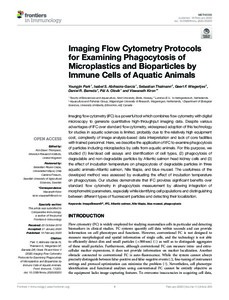| dc.contributor.author | Park, Y. | |
| dc.contributor.author | Abihssira-García, I.S. | |
| dc.contributor.author | Thalmann, S. | |
| dc.contributor.author | Wiegertjes, G.F. | |
| dc.contributor.author | Barreda, D.R. | |
| dc.contributor.author | Olsvik, P.A. | |
| dc.contributor.author | Kiron, V. | |
| dc.date.accessioned | 2021-03-21T20:34:34Z | |
| dc.date.available | 2021-03-21T20:34:34Z | |
| dc.date.issued | 2019 | |
| dc.identifier.citation | Park, Y., Abihssira-García, I.S.,
Thalmann, S., Wiegertjes, G.F.,
Barreda, D.R., Olsvik, P.A. and Kiron, V.
(2020) Imaging Flow Cytometry
Protocols for Examining Phagocytosis
of Microplastics and Bioparticles by
Immune Cells of Aquatic Animals.
Frontiers in Immunology, 11:203, 11pp.
DOI: 10.3389/fimmu.2020.00203 | en_US |
| dc.identifier.uri | http://hdl.handle.net/11329/1526 | |
| dc.identifier.uri | http://dx.doi.org/10.25607/OBP-1024 | |
| dc.description.abstract | Imaging flow cytometry (IFC) is a powerful tool which combines flow cytometry with digital
microscopy to generate quantitative high-throughput imaging data. Despite various
advantages of IFC over standard flow cytometry, widespread adoption of this technology
for studies in aquatic sciences is limited, probably due to the relatively high equipment
cost, complexity of image analysis-based data interpretation and lack of core facilities
with trained personnel. Here, we describe the application of IFC to examine phagocytosis
of particles including microplastics by cells from aquatic animals. For this purpose, we
studied (1) live/dead cell assays and identification of cell types, (2) phagocytosis of
degradable and non-degradable particles by Atlantic salmon head kidney cells and (3)
the effect of incubation temperature on phagocytosis of degradable particles in three
aquatic animals–Atlantic salmon, Nile tilapia, and blue mussel. The usefulness of the
developed method was assessed by evaluating the effect of incubation temperature
on phagocytosis. Our studies demonstrate that IFC provides significant benefits over
standard flow cytometry in phagocytosis measurement by allowing integration of
morphometric parameters, especially while identifying cell populations and distinguishing
between different types of fluorescent particles and detecting their localization. | en_US |
| dc.language.iso | en | en_US |
| dc.rights | Attribution 4.0 International | * |
| dc.rights.uri | http://creativecommons.org/licenses/by/4.0/ | * |
| dc.subject.other | Miroplastics | en_US |
| dc.title | Imaging Flow Cytometry Protocols for Examining Phagocytosis of Microplastics and Bioparticles by Immune Cells of Aquatic Animals. | en_US |
| dc.type | Journal Contribution | en_US |
| dc.description.refereed | Refereed | en_US |
| dc.format.pagerange | 11pp. | en_US |
| dc.identifier.doi | https://doi.org/10.3389/fimmu.2020.00203 | |
| dc.subject.parameterDiscipline | Parameter Discipline::Chemical oceanography::Other inorganic chemical measurements | en_US |
| dc.subject.instrumentType | Instrument Type Vocabulary::flow cytometers | en_US |
| dc.bibliographicCitation.title | Frontiers in Immunology | en_US |
| dc.bibliographicCitation.volume | 11 | en_US |
| dc.bibliographicCitation.issue | Article 203 | en_US |
| dc.description.sdg | 14.A | en_US |
| dc.description.maturitylevel | TRL 8 Actual system completed and "mission qualified" through test and demonstration in an operational environment (ground or space) | en_US |
| dc.description.bptype | Manual (incl. handbook, guide, cookbook etc) | en_US |
| obps.contact.contactname | Viswanath Kiron | |
| obps.contact.contactemail | kiron.viswanath@nord.no | |
| obps.resourceurl.publisher | https://www.frontiersin.org/articles/10.3389/fimmu.2020.00203/full | en_US |
 Repository of community practices in Ocean Research, Applications and Data/Information Management
Repository of community practices in Ocean Research, Applications and Data/Information Management

